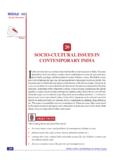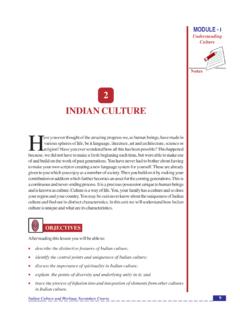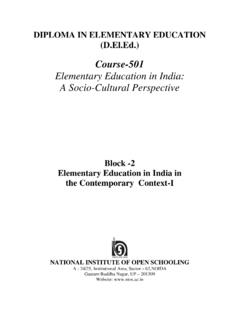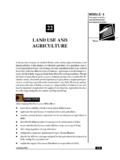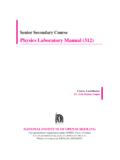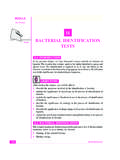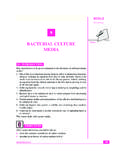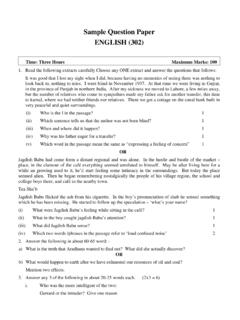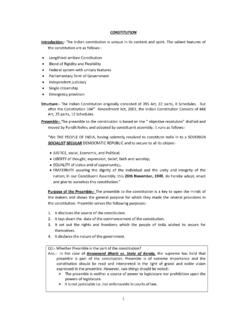Transcription of 15 CONSTITUTIONAL VALUES AND POLITICAL SYSTEM IN …
1 CONSTITUTIONAL VALUES and POLITICAL SYSTEM in india MODULE - 3. Democracy at Work 15. Notes CONSTITUTIONAL VALUES AND. POLITICAL SYSTEM IN india . Mona, who is a student of class X in a school in Shillong asked her teacher a question that had been bothering her for long. She said, Sir! in newspapers and the television news, I find the reference of the President of United States of America (USA) quite often, but the Prime Minister of USA is never mentioned. Why it is so? The teacher replied, You have rightly noticed the differences. It is so because the government of USA is based on its own constitution , whereas our governmental SYSTEM is based on our constitution .
2 It is the constitution of a country that makes provisions according to which various institutions and offices are created and are made to function. In fact, the constitution defines all aspects of the POLITICAL SYSTEM that a country has and more important than any thing else, the constitution reflects certain VALUES that form the core of that POLITICAL SYSTEM . These VALUES guide not only the government, but also the citizens and the society at large. Just like Mona, you may also have questions related to the Indian constitution and its POLITICAL SYSTEM such as, what are the VALUES reflected in the constitution ? What is the nature of the Indian POLITICAL SYSTEM ?
3 Why india is called a federal SYSTEM ? Why is it said to have parliamentary form of government? We shall discuss all these questions in this lesson. OBJECTIVES. After studying this lesson you will be able to: l explain how the constitution is the basic and fundamental law as well as a living document;. l analyze the Preamble of the constitution and identify the core VALUES reflected in it;. l appreciate the core CONSTITUTIONAL VALUES that permeate the salient features of the Indian constitution ; and l examine the nature of the Indian federal SYSTEM and the parliamentary form of government. SOCIAL SCIENCE 1. MODULE - 3 CONSTITUTIONAL VALUES and POLITICAL SYSTEM in india Democracy at Work THE constitution OF india .
4 Let us begin with a discussion on the constitution of india . But even before that the question that needs to be answered is: what is the meaning of the term constitution ? Notes Meaning of the constitution You may have come across the term constitution quite often. It is used in various contexts such as constitution of a State or a Nation, constitution of an Association or Union, constitution of a Sports Club, constitution of a non-governmental organization (NGO), constitution of a company and so on. Does this term mean the same in all these contexts? No, it is not so. As used commonly, constitution is a set of rules, generally written, which defines and regulate the structure and functioning of an organization, institution or a company.
5 But when it is used in the context of a State or a Nation, constitution means a set of fundamental principles, basic rules and established precedents (means standards/instances). It identifies, defines and regulates various aspects of the State and the structure, powers and functions of the major institutions under the three organs of the Government the executive, the legislature and the judiciary. It also provides for rights and freedoms of citizens and spells out the relationships between individual citizen and the State and government. A constitution may be written or unwritten, but it contains fundamental laws of the land. It is the supreme and ultimate authority.
6 Any decision or action which is not in accordance with it will be unconstitutional and unlawful. A constitution also lays down limits on the power of the government to avoid abuse of authority. Moreover, it is not a static but a living document, because it needs to be amended as and when required to keep it updated. Its flexibility enables it to change according to changing aspirations of the people, the needs of the time and the changes taking place in society. Unlike the Constitutions of most of the democratic countries, the British constitution is known as unwritten constitution , because it is largely unwritten and uncodified. It was not framed as a complete statement like the constitution of USA or the Indian constitution .
7 The constitution of USA and the Indian constitution are written constitutions. The Indian constitution Have you seen the document of Indian constitution ? Do you recognize the cover page shown in the illustration? If you have seen or if you get a chance to see it, you will agree that it is a very lengthy document. In fact, Indian constitution is the longest of all the written constitutions. It was prepared by a representative body, known as 2 SOCIAL SCIENCE. CONSTITUTIONAL VALUES and POLITICAL SYSTEM in india MODULE - 3. Democracy at Work the Constituent Assembly. Most of its members were deeply involved in the freedom struggle. They are respectfully called the founding fathers of the constitution .
8 The process of constitution -making was greatly influenced by the following factors: (a) aspirations generated during the long- drawn freedom struggle, (b) the CONSTITUTIONAL and POLITICAL Notes changes that took place during the British rule, (c) The ideas and thoughts of Mahatma Gandhi, popularly known as Gandhism, (d) the socio-cultural ethos of the country Figure Cover Page of the Document and (e) the experiences of the functioning of Constitutions in other democratic countries of the world. The constitution came into effect on 26 January, 1950 and since then we celebrate this day as the Republic Day every year. The Constituent Assembly began to prepare the constitution on 9 December, 1946.
9 Dr. Rajendra Prasad was elected as its President on 11 December, 1946. Dr. Baba Saheb Bhimrao Ambedkar was the Chairman of the Drafting Committee. The Constituent Assembly met for 166 days, spread over a period of 2 years, 11 months and 18 days. The making of the constitution was completed on 26. November, 1949 when the Constituent Assembly adopted the Draft constitution of india . The constitution of india defines all aspects of the Indian POLITICAL SYSTEM including its basic objectives. It has provisions regarding (a) the territories that india will comprise, (b) citizenship, (c) fundamental rights, (d) directive principles of state policy and fundamental duties, (e) the structure and functioning of governments at union, state and local levels, and (f) several other aspects of the POLITICAL SYSTEM .
10 It defines india as a sovereign, democratic, socialist and secular republic. It has provisions for bringing about social change and defining the relationship between individual citizen and the state. ACTIVITY See a copy of the constitution of india that is available in a Library or see it on the internet. Find out if there is an NGO or a Sports Club or a Students' Union or Teachers'Association or any social or cultural organisation nearby, which you may approach. Request any of them to show you the copy of the constitution they have. Compare any of these constitutions with the constitution of india . Write briefly what are the differences you find between the two?
